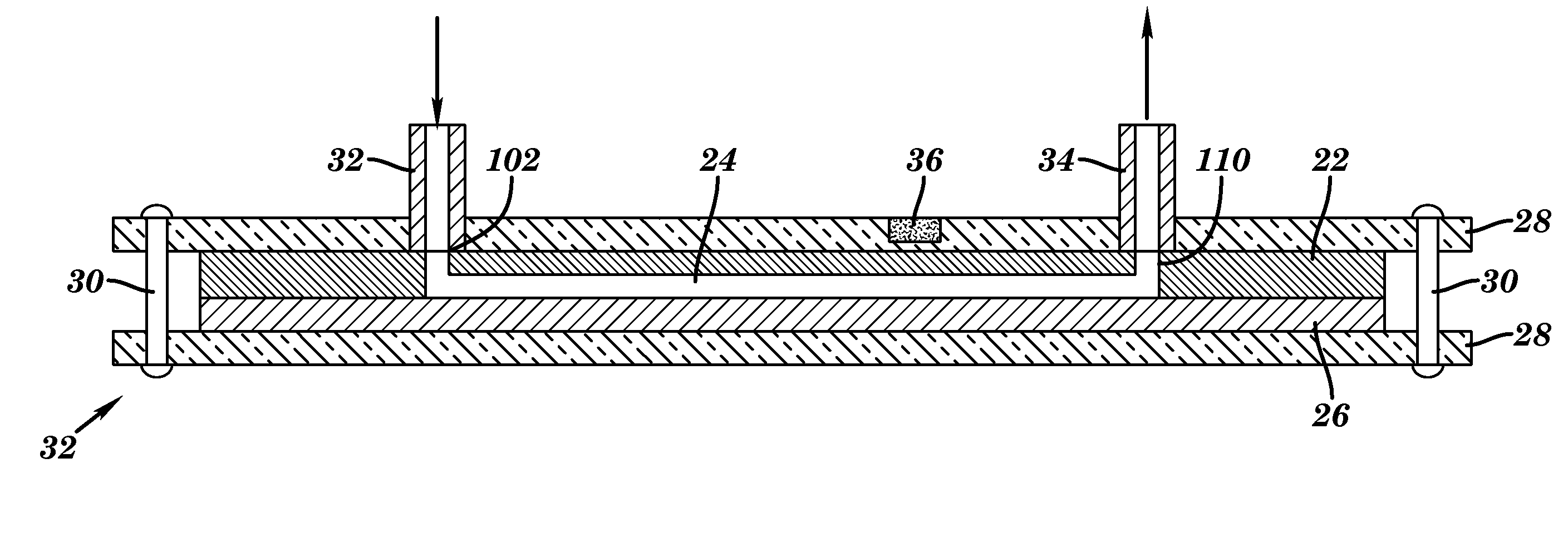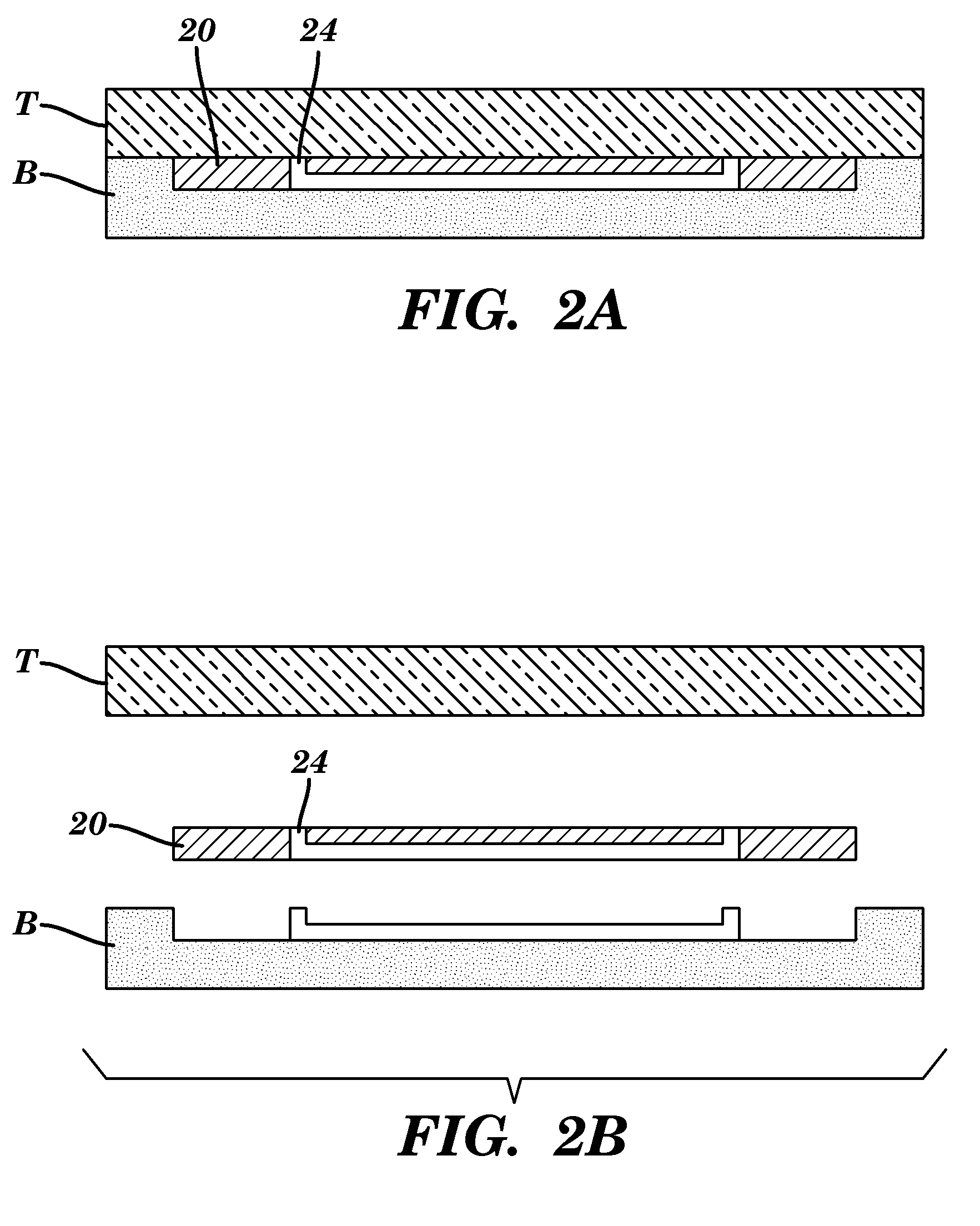Recirculating microfluidic device and methods of use
a microfluidic and microfluidic technology, applied in the field of microfluidic devices, can solve the problems of limiting the cost of equipment, achieving the least expensive and perhaps the simplest signal amplification scheme, and achieving the most accurate detection of pathogenic organisms, reducing time, and increasing sensitivity
- Summary
- Abstract
- Description
- Claims
- Application Information
AI Technical Summary
Benefits of technology
Problems solved by technology
Method used
Image
Examples
example 1
Investigation of Liposome Lysis Using the Fluorescence Detection Approach
[0133]Through inlet 102 of the microfluidic device shown in FIG. 8 and described above, a sample mixture containing complexes of bead—target RNA—liposome is introduced. A mixture containing liposomes encapsulating sulforhodamine B, magnetic beads, target RNA, and a hybridization buffer (60% formamide, 6×SSC, 0.8% Ficoll type 400, 0.01% Triton X-100, 0.15M sucrose) was injected through inlet 102. Captured beads were washed from unbound liposomes by injecting a washing buffer (10% formamide, 3×SSC, 0.2% Ficoll type 400, 0.01% Triton X-100, 0.2M sucrose) into inlet 102. At this point, signals can be detected using the CCD camera connected to the fluorescence microscope. Exposure times were optimized (1 sec), and signals were analyzed using Image Pro Express software. Alternatively, in order to increase the signal to noise ratio by lysing liposomes and obtaining a significantly higher fluorescence signal due to the...
example 2
Optimization of RNA Detection in the Microfluidic Channels
[0134]A series of experiments was performed in order to optimize the detection of RNA in the microfluidic channels. These experiments were done without any liposome lysis and were monitored using the fluorescence microscope. The amount of liposomes (1.61 OD value for 1 / 100 dilution in PBS+ sucrose buffer, pH 7.0, osmolality 630 nmol / kg) with immobilized reporter probe (FIG. 17), beads with immobilized capture probe (FIG. 18) and washing buffer (up to 14 μL) were optimized with respect to signal to noise ratio. Therefore, the limit of detection was obtained for the analysis of Dengue virus RNA. The amount of reporter probe was 0.013 mol % from the total amount of lipids. The biotinylated capture probe was immobilized on the surface of the beads (Dynabeads MyOne Streptavin) following the manufacturer protocol. 1 mg of the beads binds approximately 3,000 pmoles of free biotin.
example 3
Electrochemical Analysis of Liposome Capture in the Microfluidic Device
[0135]To test the IDUA response in microfluidic system, as shown in FIG. 10, different volumes (20 nL-100 nL) of 10 μM potassium hexaferrocyanide / potassium hexaferricyanide solution were injected at flow rate of 1 μl / min into inlet 108, while buffer solution was introduced at flow rate of 1 μl / min through inlet 102. The typical result of the IDUA response in the single continuous run is provided in FIG. 20.
[0136]These results demonstrated that indeed the system based on the IDUA is capable of a fast response to the electrochemical composition changes inside the channel. The delay time between injection and the maximum signal reached was about 5-7 sec. In all the experiments the IDUA itself demonstrates a good reproducibility and the ability to function for prolonged periods of time without mechanical cleaning.
[0137]The typical results of RNA analysis by means of electrochemical detection is present in FIG. 21. In...
PUM
| Property | Measurement | Unit |
|---|---|---|
| bias potential | aaaaa | aaaaa |
| flow rate | aaaaa | aaaaa |
| length | aaaaa | aaaaa |
Abstract
Description
Claims
Application Information
 Login to View More
Login to View More - R&D
- Intellectual Property
- Life Sciences
- Materials
- Tech Scout
- Unparalleled Data Quality
- Higher Quality Content
- 60% Fewer Hallucinations
Browse by: Latest US Patents, China's latest patents, Technical Efficacy Thesaurus, Application Domain, Technology Topic, Popular Technical Reports.
© 2025 PatSnap. All rights reserved.Legal|Privacy policy|Modern Slavery Act Transparency Statement|Sitemap|About US| Contact US: help@patsnap.com



